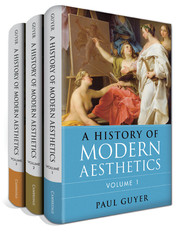Book contents
- Volume 1 The Eighteenth Century
- Volume 2 The Nineteenth Century
- Frontmatter
- Contents
- Acknowledgments
- Introduction
- Part One German Aesthetics in the First Half of the Nineteenth Century
- 1 Early Romanticism and Idealism
- 2 High Romanticism in the Shadow of Schelling
- 3 The High Tide of Idealism
- 4 In the Wake of Hegel
- Part Two (Mostly) British Aesthetics in the Second Half of the Nineteenth Century
- Part Three German Aesthetics in the Second Half of the Nineteenth Century
- Bibliography
- Index
- Volume 3 The Twentieth Century
- References
1 - Early Romanticism and Idealism
Schlegel and Schelling
from Part One - German Aesthetics in the First Half of the Nineteenth Century
Published online by Cambridge University Press: 05 June 2015
- Volume 1 The Eighteenth Century
- Volume 2 The Nineteenth Century
- Frontmatter
- Contents
- Acknowledgments
- Introduction
- Part One German Aesthetics in the First Half of the Nineteenth Century
- 1 Early Romanticism and Idealism
- 2 High Romanticism in the Shadow of Schelling
- 3 The High Tide of Idealism
- 4 In the Wake of Hegel
- Part Two (Mostly) British Aesthetics in the Second Half of the Nineteenth Century
- Part Three German Aesthetics in the Second Half of the Nineteenth Century
- Bibliography
- Index
- Volume 3 The Twentieth Century
- References
Summary
Back to Kant
Let us begin with a brief review of the central themes of Kant’s aesthetics that will be relevant to what follows. Kant began from the challenge posed by mid-eighteenth-century aesthetic theory, for example by Hume’s essay “Of the Standard of Taste,” by Gerard’s Essay on Taste, and many other works ultimately going back to Du Bos, to explain how a judgment of taste, paradigmatically a judgment that a particular object is beautiful, can be made only on the basis of a feeling of pleasure in response to an object, independent of any determinate concept of or rule for that object, and yet be valid for all qualified observers of the object responding to it under appropriate conditions. Kant did not present this challenge merely as one raised by previous philosophers, but as one raised by common sense and practice. He began by accepting from Shaftesbury and Hutcheson that a judgment of taste must be disinterested, independent of any personal physiological, prudential, or moral interest in the existence of the object. But disinterestedness seems to be merely a necessary condition for universal validity: one’s pleasure in an object might be independent of any identifiable interest, yet still be utterly accidental or idiosyncratic. To find a sufficient condition for the universal validity of the judgment of taste, Kant sought its ground in a mental state that is disinterested and free from regulation by determinate concepts but nevertheless can be reasonably expected from all normal human beings who themselves approach the object without an antecedent interest in or preconception of what the object ought to be.
- Type
- Chapter
- Information
- A History of Modern Aesthetics , pp. 11 - 56Publisher: Cambridge University PressPrint publication year: 2014



